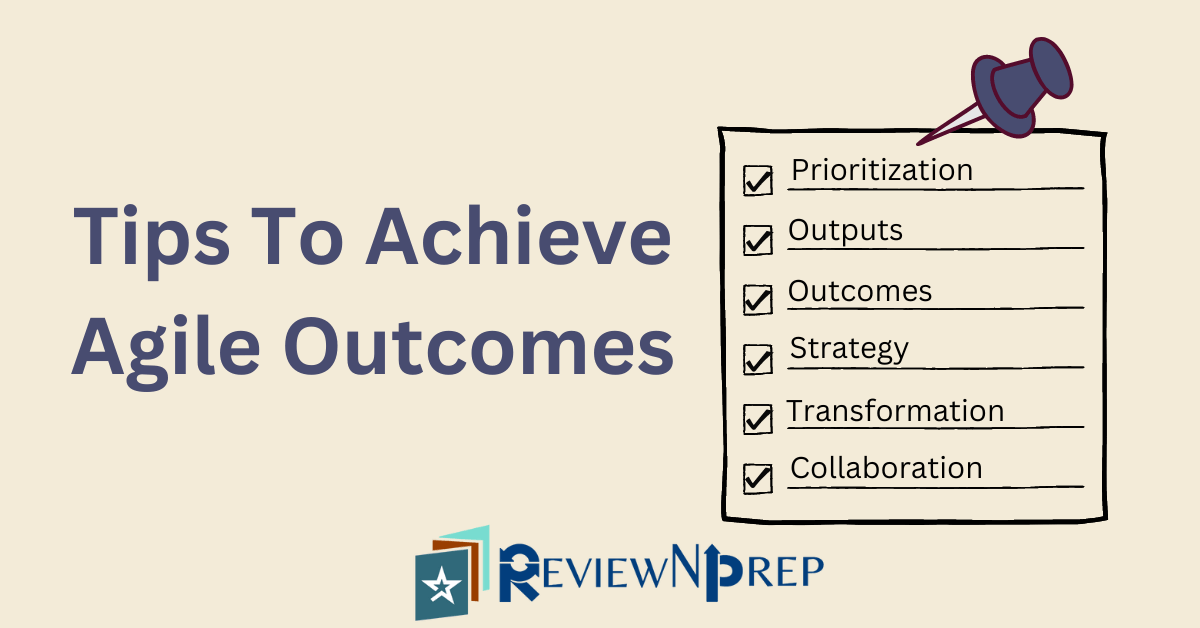|
|
There are many different types of Agile Outcomes, but some common ones include increased speed and agility in delivering products or services, improved customer satisfaction, reducing cycle time, improving quality, and reducing waste.and reduced costs.
It’s important to consider which business outcomes are most important when planning your agile strategy. Once you’ve identified which outcomes are most important to you, it’s then possible to measure them in order to determine if you’re achieving success.
Measuring outcomes is an important part of agile success, as it allows you to track your progress and make adjustments as needed. It’s also important to remember that not all outcomes are created equal – some may be more important than others. Ultimately, it’s up to the individual business unit to decide which outcomes they’re interested in achieving.
Related: Getting started with Scrum guide
Do not confuse Outcome with Output
An Output is the result of completing an action, whereas an Outcome is what you’re trying to achieve. For example, reducing cycle time may be an Output, but achieving customer satisfaction might be an important Outcome.
Another way to look at this would be, outcomes are a lagging indicator whereas outputs are a leading indicator. Setting up mini-goals to achieve the big goal is essential to achieve the desired outcome.
This is why it’s important to focus on outputs rather than outcomes when trying to achieve a goal. By focusing on outputs, you can more easily see the progress you’re making and adjust your strategy accordingly.
Although measuring and achieving key agile outcomes can be difficult, it’s essential for success. By following a proper agile strategy, you can increase your speed and agility while maintaining high quality output.
Steps to achieve desired Agile outcomes
Below are some steps you can follow to achieve good Agile outcomes:
- Create a clear vision: A clear vision will help everyone on your team understand why they’re working on certain projects and what the end goal looks like. Product teams are generally responsible for ensuring the vision is clearly stated and defined. This will help keep everyone on track and ensure that all the work is directed towards a common goal aka outcome.
- Prioritization is the key: Product owners should start by identifying which outcomes are most important to your business and the development teams should focus all efforts on those. Often competing priorities and too much work in progress (WIP) can lead to unsuccessful implementation of Agile.
- Refine your backlog often: As you implement and measure your agile strategy, it’s important to continually refine your backlog. This means that Product owner need to be able to rapidly generate new ideas and features, and that you have the ability to track progress and make changes as needed. Scrum Team should honor the product owners priority and sprint goals.
- Measure progress regularly: Keeping track of progress is essential in order to make adjustments as needed. By monitoring how things are changing, you can ensure that you’re making the most effective use of your time and resources. Objective and Key results (OKR’s) is another way to measure outcomes.
- Encourage team collaboration: Encourage collaboration between team members and promote sharing of knowledge and ideas. This will help reduce duplication of effort, improve communication, and create a more cohesive team. If the Agile team is not happy, chances are both the output and outcome will suffer.
- Measure and track progress: Make sure you measure and track progress regularly so you can identify any areas where improvements are needed. It is important to note that you should measure what matters. For example measuring velocity by itself will not be much helpful in driving to any meaningful change.
- Adhere to principles: Follow the principles of Agile such as customer-centricity, continuous delivery, and quick feedback cycles in order to achieve successful outcomes. Self-organizing, cross-functional teams are the cornerstone for successful agile practices.
- Continuous learning is key: Delivery teams should keep adapting and learning new techniques to help you achieve even faster and more agile outcomes.
Conclusion
Agile Transformation has become a buzzword in today’s business world. Companies are shifting from delivering agile projects to creating an entire agile organization. Successfully implementing an agile strategy can be a challenge, but with the right steps and principles in place, you can achieve great outcomes.
Further Reading:
Agile, DevOps, CI/CD – How are they related explained in the blog
Set your sprint goals and ways to achieve them efficiently and effectively

